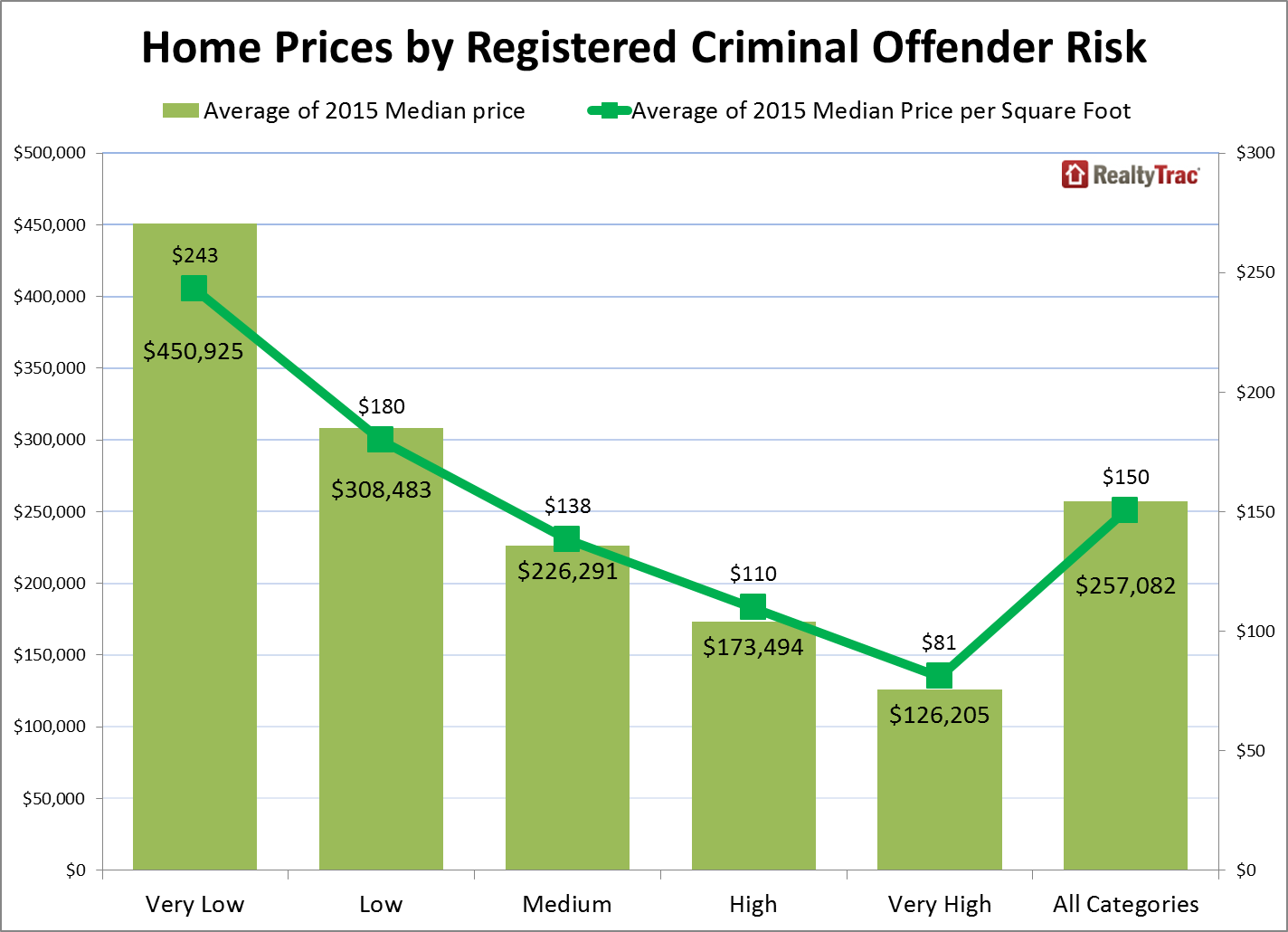Agents of homebuyers looking for a place to raise their family in relative safety from personal crimes may now easily review the criminal activity of a neighborhood, thanks to RealtyTrac’s latest Registered Criminal Offender Risk Index.
The index uses California’s sex offender registry to generate a 0 to 100 score based on the number of criminal sex offenders as a percentage of the local population. A higher index number means a correspondingly higher percentage of the local population are registered sex offenders. Conversely, a lower index number indicates fewer members of the local population are registered sex offenders.
The index for California only yields information on registered sex offenders available through the state’s registry. However, in some other states the data includes multiple types of criminal offenders.
The California index uses the percentage of sex offenders to categorize an area into a risk category of:
- Very High;
- High;
- Medium;
- Low; or
- Very Low.
The criminal index is integrated into RealtyTrac’s property data web sites, www.homediclosure.com and www.homefacts.com. These sites provide local statistics about:
- all types of local crimes, including violent crimes, burglaries and property theft; and
- how local crime rates compare to state and national averages.
Homebuyers and their agents can easily research an area by city, address or zip code to review crime information.
The link between crime and home values
Accompanying the debut of the index are data that a higher percentage of criminal offenders are linked to lower property values and higher foreclosure rates — a fear-mongering warning to homebuyers that registered criminal offenders nearby pose not just a security risk, but possibly a financial risk as well.
RealtyTrac reports that, as of the first quarter of 2016, homes located in zip codes with a “Very Low” offender index were valued more than three times higher than homes located in zip codes with a “Very High” offender index.
But readers need to take all this reductionist thinking with a grain of salt. Recall first the maxim: correlation of facts does not imply causation of results. While the simplified mathematical analysis does not consider other social and economic factors and, frankly, is wrong-footed in its positioning of a higher number of local criminal offenders as a direct cause of future value depreciation and foreclosures, it does raise the issue of whether crime has a negative impact on housing values, or vice versa.
Increased crime has been shown to exert downward pressure on property values as it influences how buyers perceive the security within a community, reducing desirability and lowering the price buyers are willing to pay to take on the potential added risk.
The chicken or the egg
Mixed results from research into crime and home values attest to the complexity of the issue requiring a more nuanced analysis. Some studies found only violent crimes have a meaningful effect on home values; another shows increased crime resulting from a reduced police force may instead cause home values in a neighboring city to increase, comparable to a lack of fire hydrants and proximity to fire stations having an effect on insurance premiums.
Conversely, the link between fewer governmental resources in lower-valued communities and increased crime is also explored in housing studies cited by the Department of Housing and Urban Development (HUD). The studies show a scarcity of finance capital, employment opportunities and institutional resources in impoverished communities contribute to more crime, and not the other way around.
Further contributing to this link are the obstacles ex-offenders face finding employment and housing after exiting the criminal justice system — which recent housing policy attempts to rectify.
Relegated to the status of a second class citizen, ex-offender reentry into society is marred by their criminal record. Any criminal background prevents their obtainment of a job and sufficient income to support themselves — regardless of rehabilitation or the likelihood of reoffending. These barriers and lack of resources and community support push ex-offenders into lower cost neighborhoods where they have the best chance of surviving.
Thus, it is not merely the existence of ex-offenders in a neighborhood that lower home values, but lower home values that attract struggling ex-offenders lest they become homeless. However, for homebuyers, this process becomes apparent in neighborhood statistics that translate into a higher risk to their security and, potentially, their largest financial asset.
While the relationship between crime and future home values is complex — and involves factors the index does not address — perhaps what the index makes clearer is the potential for higher crime rates to disproportionately impact buyers of low-tier properties. For real estate agents representing buyers and sellers in low-tier communities, local crime information is especially relevant — a material fact to any buyer — and may be a significant factor in determining whether your buyer will submit an offer, and if so, on what informed terms.
A growing demand for crime data
No matter the cause, effects or frequency of criminal activity in a neighborhood, one thing is clear: crime rates are a major consideration for many homebuyers evaluating properties in any neighborhood. This concern is likely most acute when your buyer is a family with children. However, everyone highly values their personal safety and the security of their property, children or not.
A recent first tuesday poll found, according to agents, low crimes rates topped the list as the most important factor for homebuyers searching for a home, even surpassing quality schools and proximity to work.
With current events — local and global — raising concerns about violence and safety in a community, real estate agents can expect crime to be an increasingly significant property aspect for buyers.
Homebuyers want to be assured the neighborhood they choose is a safe environment for their families. However, as crime is erratic and not typically something sellers or their agents can predict, discussing criminal activity may be a difficult hurdle for some agents.
Real estate agents are best advised to keep in mind that, though they are not legally obligated to voluntarily investigate the crime activity in the vicinity of a property, agents and sellers are required to disclose any known material facts that adversely affect the use and desirability of a property. This includes a local nuisance and, thus, includes known criminal activity. Just ask the buyer, if you are doubtful about the importance of this type of data. [Calif. Civil Code §1102.1]
Disclosure of criminal activity
Currently, California law does not but needs to mandate seller disclosure of known criminal activity in a neighborhood. Seller’s agents are fully informed about where the data is and the data is readily available to them (as well as the sellers). Gathering and giving notice to prospective buyers requires little effort compared to the value of the service to the public and satisfaction of buyers.
When the seller is aware of repeated criminal offenses on or near a property, they have a pricing issue which is why the activity rises to a material fact. Evidence of crimes against persons and property may have an adverse effect on the price they can get from a buyer, unless the risk is already priced into housing in the area. The best practice for agents to comply with their licensing duties is to disclose this information to a prospective buyer by using a form designed for this very purpose. [See RPI Form 321]
Further, when asked by a buyer or their agent, sellers and seller’s agents are required to respond truthfully and fully to any inquiries about their knowledge of criminal activity. However, rules need to impose a duty on seller’s agents to seek out this information by checking local sources on the history in the neighborhood in which the listing is located. This is a public service a licensee owes to members of the public, unrestricted by the mere fact the seller may want to deceive the buyer to get the highest price for the property on a sale. All this is about asymmetry of information through the lack of transparency which leaves the buyer knowing less than the seller and the seller’s agent about the property.
To better protect homebuyers, first tuesday advocates for legislation requiring sellers to include a criminal activity disclosure in all residential sales. Just as the seller and seller’s agent are required to disclose the existence of environmental, natural hazards and the physical condition of the property, the existence of hazards brought on by criminal activity needs disclosure at the earliest possible moment (ASAP), preferably before a buyer submits an offer, but always before the seller enters into a contract to sell to a buyer.
Until then, buyer’s agents need to be attentive to buyer concerns regarding local crime rates — the new criminal sex offender index for California can provide some assistance — and encourage, if not demand, sellers to disclose known information about local criminal activity to reduce everyone’s risk of deceitful conduct claims by an ill-informed buyer. [See RPI Form 321]















